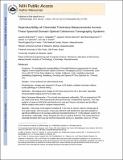Reproducibility of Choroidal Thickness Measurements Across Three Spectral Domain Optical Coherence Tomography Systems
Author(s)
Branchini, Lauren; Regatieri, Caio V.; Flores-Moreno, Ignacio; Baumann, Bernhard; Fujimoto, James G.; Duker, Jay S.; ... Show more Show less
DownloadFujimoto_Reproducibility of.pdf (550.6Kb)
PUBLISHER_CC
Publisher with Creative Commons License
Creative Commons Attribution
Terms of use
Metadata
Show full item recordAbstract
Purpose
To investigate the reproducibility of choroidal thickness measurements in normal subjects on 3 spectral domain optical coherence tomography (SD-OCT) instruments: Zeiss Cirrus HD-OCT (Carl Zeiss Meditec Inc., Dublin, CA), Heidelberg Spectralis (Heidelberg Engineering, Heidelberg, Germany), and Optovue RTVue (Optovue Inc., Fremont, CA).
Design
Cross-sectional non-interventional study.
Participants
Images were obtained in 28 eyes of 28 healthy undilated volunteers without ocular pathology in a clinical setting.
Methods
All subjects were imaged on the fovea using Cirrus HD 1-line raster, Spectralis enhanced depth imaging (EDI), and RTVue retina-cross.
Main Outcome Measures
The choroid was measured subfoveally, 750 μm temporal, and 750 μm nasal to the fovea. All measurements were performed by 2 independent observers. Two-way analysis of variance (ANOVA) with Bonferroni's post-test, Pearson correlation, and Bland–Altman analysis were used to compare measurements.
Results
The group of 28 subjects consisted of 7 men and 21 women, with an average age of 35.2 years (range, 23–64 years). A 2-way ANOVA with Bonferroni's post-test revealed no significant difference in the average subfoveal choroidal thickness (P > 0.05) among systems for any location: subfoveally, 750 μm temporal, and 750 μm nasal to the fovea. The measurements of choroidal thickness from any pair of 3 instruments (Cirrus vs. Spectralis, Cirrus vs. RTVue, Spectralis vs. RTVue) were also strongly correlated. The Pearson correlation among all 2 system pairs of the 3 systems was greater than 0.9 (P < 0.0001). The 95% limits of agreement among 4 choroidal thickness measurements were +11.21% to −13.57% (bias −1.17) between Cirrus and RTVue, +10.85% to −12.45% (bias −0.80) between Spectralis and RTVue, and +12.81% to −13.33% (bias −0.25) between Cirrus and Spectralis.
Conclusions
In our population of young healthy adults with normal vision, there was good reproducibility among choroidal thickness measurements of images acquired with Cirrus, Spectralis, and RTVue.
Date issued
2011-09Department
Massachusetts Institute of Technology. Department of Electrical Engineering and Computer Science; Massachusetts Institute of Technology. Research Laboratory of ElectronicsJournal
Ophthalmology
Publisher
Elsevier
Citation
Branchini, Lauren, Caio V. Regatieri, Ignacio Flores-Moreno, Bernhard Baumann, James G. Fujimoto, and Jay S. Duker. “Reproducibility of Choroidal Thickness Measurements Across Three Spectral Domain Optical Coherence Tomography Systems.” Ophthalmology 119, no. 1 (January 2012): 119–123.
Version: Author's final manuscript
ISSN
01616420